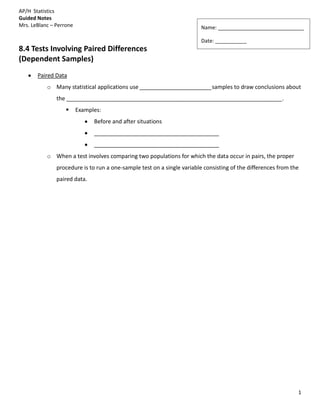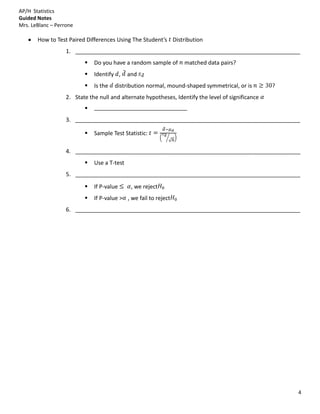8.4 guided notes
- 1. AP/H Statistics Guided Notes Mrs. LeBlanc â Perrone Name: ______________________________ Date: ___________ 8.4 Tests Involving Paired Differences (Dependent Samples) Paired Data o Many statistical applications use _______________________samples to draw conclusions about the _____________________________________________________________________. ï§ Examples: Before and after situations ________________________________________ ________________________________________ o When a test involves comparing two populations for which the data occur in pairs, the proper procedure is to run a one-sample test on a single variable consisting of the differences from the paired data. 1
- 2. AP/H Statistics Guided Notes Mrs. LeBlanc â Perrone Components of the Paired Test o Hypotheses ï§ When testing the mean of the differences of paired data values, the null hypothesis states that â_____________________________________________________â ( ) ï§ The null hypothesis is always ___________________ ï§ The alternate hypothesis depends on the problem and can be: Left-Tailed Right-Tailed Two-Tailed o ï§ ________________________________________________________________________ ï§ Take the measurements from one setâ measurements of the other set, then find the mean (add up the differences and divide by the number of data pairs) This can be done in the calculator o Enter the âafterâ values in L1 o Enter the âbeforeâ values in L2 o Highlight L3, type L1 â L2, press ENTER (L3 should populate with the differences) o Hit Stat, tab over to calc, choose 1:1-Var Stats, use L3 hit ENTER ï§ ï§ S o For paired difference tests, we make our decision regarding H0 according to the evidence of _______ o ï§ ________________________________________________________________________ 2
- 3. AP/H Statistics Guided Notes Mrs. LeBlanc â Perrone o Sample Test Statistic ï§ o P-Value ï§ ________________________________________________________________________ ________________________________________________________________________ 3
- 4. AP/H Statistics Guided Notes Mrs. LeBlanc â Perrone How to Test Paired Differences Using The Studentâs Distribution 1. ________________________________________________________________________ ï§ Do you have a random sample of matched data pairs? ï§ Identify , and ï§ Is the distribution normal, mound-shaped symmetrical, or is ? 2. State the null and alternate hypotheses, Identify the level of significance ï§ 3. ________________________________________________________________________ ï§ Sample Test Statistic: 4. ________________________________________________________________________ ï§ Use a T-test 5. ________________________________________________________________________ ï§ If P-value , we reject ï§ If P-value > , we fail to reject 6. ________________________________________________________________________ 4
- 5. AP/H Statistics Guided Notes Mrs. LeBlanc â Perrone Example: Paired Differences A team of heart surgeons at Saint Annâs Hospital knows that many patients who undergo corrective heart surgery have a dangerous buildup of anxiety before their scheduled operations. The staff psychiatrist at the hospital has started a new counseling program intended to reduce this anxiety. A test of anxiety is given to patients who know they must undergo heart surgery. Then each patient participates in a series of counseling sessions with the staff psychiatrist. At the end of the counseling sessions, each patient is retested todetermine anxiety level. Table 8-8 indicates the results for a random sample of nine patients. Higher scores mean higher levels of anxiety. Assume the distribution of differences is mound-shaped and symmetric. From the given data, can we conclude that the counseling sessions reduce anxiety? Use a 0.01 level of significance. 5
- 6. AP/H Statistics Guided Notes Mrs. LeBlanc â Perrone Summary Questions 1. Are data that can be paired independent or dependent? (Hint: we talked about independent and dependent in Chapter 7) ____________________________________________________________________________________ ____________________________________________________________________________________ ____________________________________________________________________________________ ____________________________________________________________________________________ 2. When testing the difference of means for paired data, what is the null hypothesis? What does it mean? ____________________________________________________________________________________ ____________________________________________________________________________________ ____________________________________________________________________________________ ____________________________________________________________________________________ 3. What elements of testing with P-values are consistent in every situation ( )? ____________________________________________________________________________________ ____________________________________________________________________________________ ____________________________________________________________________________________ ____________________________________________________________________________________ ____________________________________________________________________________________ ____________________________________________________________________________________ ____________________________________________________________________________________ ____________________________________________________________________________________ âHOTâ Question: __________________________________________________________________________________________ __________________________________________________________________________________________ 6





